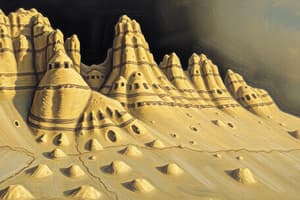Podcast
Questions and Answers
What is the term for the process of wind removing the top layer of fine sediment, leaving behind rocks that are too heavy to be lifted?
What is the term for the process of wind removing the top layer of fine sediment, leaving behind rocks that are too heavy to be lifted?
- Deflation (correct)
- Erosion
- Abrasion
- Deposition
What type of glacier forms in a mountain area, creating a rugged landscape?
What type of glacier forms in a mountain area, creating a rugged landscape?
- Alpine Glaciers (correct)
- Continental Glaciers
- Loess
- Glacial Drift
What is the term for the extremely slow movement of materials downslope?
What is the term for the extremely slow movement of materials downslope?
- Landslide
- Creep (correct)
- Rockfall
- Mudflow
What is the term for the process of wind carrying extremely fine material long distances?
What is the term for the process of wind carrying extremely fine material long distances?
What is the term for the process of glaciers moving and depositing materials?
What is the term for the process of glaciers moving and depositing materials?
What is the term for the sudden rapid movement of a large amount of material downslope?
What is the term for the sudden rapid movement of a large amount of material downslope?
What is the term for the grinding and wearing down of rock surfaces by other rock or sand particles?
What is the term for the grinding and wearing down of rock surfaces by other rock or sand particles?
What is the term for thick sheets of ice that may spread over entire continents?
What is the term for thick sheets of ice that may spread over entire continents?
Flashcards are hidden until you start studying
Study Notes
Wind Erosion and Deposition
- Wind shapes the Earth through abrasion, deflation, dunes, and loess
- Abrasion is the grinding and wearing down of rock surfaces by other rocks or sand particles
- Deflation is the removal of top layers of fine sediment by wind, leaving behind rocks that are too heavy to be lifted
- Dunes are mounds of wind-deposited sand that move in the same direction as the wind
- Loess is a thick deposit of fine-grained sediment carried long distances by wind
Ice Erosion and Deposition
- Ice shapes the Earth through glacial drift, alpine glaciers, and continental glaciers
- Glacial drift is the process of glaciers moving under gravity, picking up materials (erosion) and depositing them as they melt
- Alpine glaciers form in mountain areas, creating rugged landscapes
- Continental glaciers are thick sheets of ice that spread over entire continents, eroding and removing existing features
Gravity Erosion and Deposition
- Gravity shapes the Earth through creep, rockfall, landslide, and mudflow
- Creep is the extremely slow movement of materials downslope, influenced by factors such as water, plant roots, and burrowing animals
- Rockfall is the sudden falling of loose rocks down a steep slope
- Landslide is the sudden rapid movement of a large amount of material downslope
- Mudflow is the rapid movement of a large mass of mud
Studying That Suits You
Use AI to generate personalized quizzes and flashcards to suit your learning preferences.




